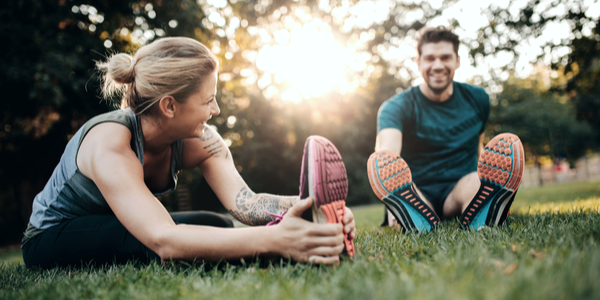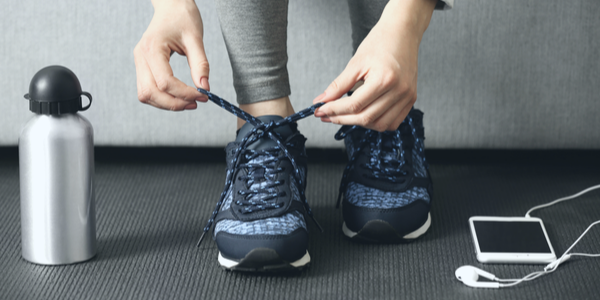
Most people are aware of the physical health benefits of exercise like maintaining a healthy weight, lowering blood pressure, reduced risk of chronic diseases, and improved strength and endurance among others. But in addition, the psychological benefits of exercise also exist.
The emotional and mental benefits of exercise are so profound, many health professionals deem it as powerful treatment as pharmaceutical drugs. If curious to learn more, read on to learn how exercise can improve your mood.
8 Mental Benefits of Exercise
From reducing anxiety to increasing confidence, the benefits of exercise on mental health are profound. Learn more about each below and find out how to get started immediately following!
1. Eases Depression and Anxiety
A natural mood lifter, physical activity releases chemicals known as endorphins that produce feelings of euphoria and happiness. Moderate exercise throughout the week is so effective at easing depression and anxiety that many doctors propose trying it before trialing medication.
2. Reduces Stress
Although exercise is technically an acute form of stress, the heart rate raising effects also stimulate the production of neurohormones such as norepinephrine and dopamine which promote clear thinking.
Additionally, during exercise the central and sympathetic nervous systems work in tandem, leading to an enhanced ability to respond to stress.
3. Increases Self-Esteem and Confidence
Because of its mood-lifting abilities, exercise can inherently improve self-esteem and confidence as well. Evidence reveals people tend to feel better about themselves if they worked out that day despite any obvious or physical changes.
Furthermore, completing a workout is efficacious, boosting the relationship between mind, body, and spirit.
4. Improves Brain Function
Much research correlates exercise with building intelligence, strengthening memory, and improving cognitive function overall. Through a process known as neurogenesis, the building of new brain cells and pathways, the brain boosts its function and performance.
Cardiovascular forms of exercise also enhance a part of the brain called the hippocampus, known for its memory and learning functions.
5. Promotes Better Sleep
When not completed too close to bedtime, exercise actually promotes sound sleep by raising body temperature which has calming effects on the mind and regulating circadian rhythm.
The circadian rhythm is like a natural body alarm clock. It essentially signifies when the body needs rest so it can grow, repair, and restore.
6. Boosts More Energy
Although somewhat counterintuitive, regular physical activity improves natural energy levels. It does so by increasing blood flow, which carries oxygen and nutrients to cells, muscles, and organs. This enhances mental alertness and zest.
Research reveals that people who regularly work out tend to be more productive at work and in their personal lives too.
7. Strengthens Relationships
Not as regularly regarded, movement can strengthen interpersonal relationships, especially when completed with a friend. In addition to keeping one another more motivated and accountable, it offers quality time to spend with each other.
Plus, thanks to the aforementioned positive effects, when one develops a strong relationship with themself, they can build deeper relationships with others as well.
8. Enhances Creativity
Creativity is the ability to create new ideas or solve problems in innovative ways and exercise has shown to enhance it. In fact, even the act of walking improves creative inspiration according to a Stanford study.
Researchers examined the creativity levels of people while they walked versus while they sat. A person's creative output increased by an average of 60 percent when walking and remained apparent even shortly after!
The study strengthens the justification for integrating bouts of physical activity into the day, whether recess at school or turning a meeting at work into a walking one. "We'd be healthier, and maybe more innovative for it," suggests Marily Oppezzo, a Stanford doctoral graduate in educational psychology and co-author of the study.
Outdoor Activities
Exercise need not be one type fits all and there are numerous different physical activities. Finding a few enjoyable ones will ensure exercise remains a sustainable habit as opposed to a resolution that flatlines by February year after year.
Walk/Run
One of the simplest and cheapest ways to reap the benefits of moving more, walking, jogging, or running outdoors in fresh air (and suitable temperatures) is an excellent option. Even better when done with a friend or workout buddy!
Take a walk around the neighborhood or enjoy new scenery at a local park, state park, around a nearby lake. If geography permits, venture along the beach or through the mountains.
Class at the Park
Nowadays, many personal and group trainers conduct their sessions outdoors and in local parks. Check out local Facebook groups, clubs, and forums to discover different options or ask local gym trainers if such an opportunity exists and how to join!
Or even better, take the initiative to start your own. Use fitness apps or online trainers to program and progress strategically.
Chasing and Playing with Kids
Physical activity does not always have to be regimented or programmed. General movement confers positive consequences as well. And sometimes, running, chasing, and picking up kids is as tough as a real workout anyways.
Yard Work
For reference, heavy yard work such as landscaping and moving rocks can burn 400 to 600 calories per hour. Lower intensity activities, like gardening and pulling weeds, burn about 200 to 400 calories in an hour.
The heavier and lighter chores are on par with a high-intensity cardio workout and lower intensity strength session respectively.
Backyard Circuits
Not only does exercise elicit mental health perks, but research also shows fresh air does the same. Combine those two and the result is increased happy hormones, better stress management, and clear-minded thinking.
Options include resistance circuits, hill sprints, or gentle yoga under the sun.
Swimming
A stellar form of low-impact cardio, swimming, and/or water aerobics heighten the cardiovascular system and burn substantial energy. The workout can be as simple as swimming laps for 30 minutes or increased in intensity by implementing intervals, bursts of treading water, or taking a class led by a qualified trainer.
Snow or Sand Sports
Snow and sand naturally provide resistance, leading muscles to work harder and the heart to pump quicker. Experimental research shows running on sand is about 1.6 times more difficult than on land.
Not to mention snow sports like skiing and snowboarding are equivalent to a 5-6 mile run, effort and calorie burn wise.
Indoor Activities
When the weather will not cooperate, indoor physical activity awaits. While the extended benefits of fresh air are not there, workout equipment that isn’t accessible outdoors proves advantageous.
Yet, strategically programmed bodyweight workouts and impromptu dance parties can be just as effective, physically and mentally too.
Gym
Obviously, this is one of the most popular indoor exercise methods. The standard gym usually offers ample equipment and machines, comradery, and motivating decor, making it a solid choice.
Other amenities depending on the gym can include group classes, personal training, cycle studios, saunas, juice and supplement bars, and massage lounges among others.
Home Workouts
Another simple and very affordable option, home workouts can be surprisingly difficult and more importantly, completely tailored. While some people prefer a yoga mat and a YouTube video to follow, others may boast a room or garage equipped with dumbbells, machines, barbells, Bosu balls, and the like.
The setup and workouts are totally up to personal preference, but people who enjoy programming or creating their own workouts tend to fare better with this choice.
Studio Classes
For those seeking slightly more guidance, specific studio classes like boot camps, cycling, boxing, TRX, climbing, or rowing workouts might be a wiser option. Led by trained professionals, one can expect guidance and group motivation to bolster the sweat sesh.
Household Chores
Cleaning and tidying the home make a great active rest day option. Working out intensely every day can lead to burnout and a slew of health problems, so taking 1 to 2 rest days weekly is beneficial.
However, light activity on those days is still encouraged, and sprucing the house fulfills that conquest.
Dance Parties
Last but not least, freely dancing, dynamically stretching or a combination of both admirably contribute to positive mental and physical health. Nothing allows for a better mind-to-body connection than expressing energy through flowy movement.
So, set the timer for 30-60 minutes, play some upbeat or moody tunes and get groovy!
The Bottom Line
From easing depression to promoting better relationships, regular exercise and physical activity are like magical mental medicine. Not only as treatment but as a preventative measure too. Even better, no one kind or style of exercise is best, giving everyone the opportunity to discover their favorites.
Do not miss out on moving mindfully and experiment with a few of the plentiful options provided above to create a sustainable, motivating, and ultimately fun exercise plan for the long run.
References:
The Mental and Emotional Benefits of Exercise. True Fitness. Published April 17, 2020. www.truefitness.com/resources/mental-emotional-benefits-exercise/.
Five Mental Benefits of Exercise. Walden University. Published October 23, 2020. www.waldenu.edu/online-bachelors-programs/bs-in-psychology/resource/five-mental-benefits-of-exercise.







